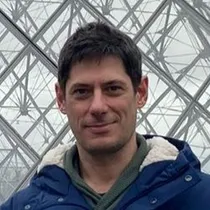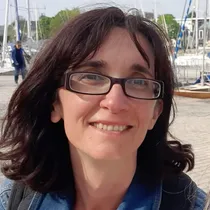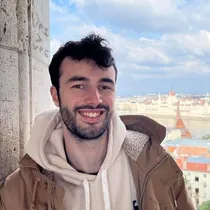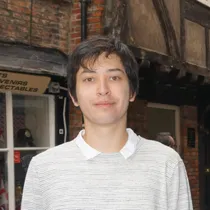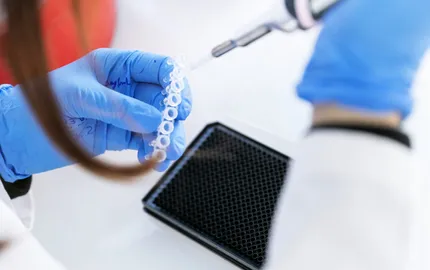Presentation

Our scientific goal is to provide, via organic chemistry and synthesis, small molecules as druggable candidates and chemical probes for a better understanding of biological processes in the field of cancer.
The discovery of new molecules interacting with living organisms benefits from the team’s expertise in modeling and molecular dynamics.
Our research team is structured around four main activities: a) 1-2 photon molecular probes with fluorogenic, click-and-release and targeting properties; b) radiation-actuatable therapeutics; c) drug discovery programs; d) molecular modelling. Our team integrates approaches in theoretical chemistry, synthetic chemistry, biophysics, chemical biology, medicinal chemistry and biology to advance projects.
a) Fluorogenic probes for mono- and bi-photon absorption for applications in cellular imaging, click-and-release approaches and fluorescence-guided surgery.
Florence Mahuteau-Betzer (PI), Kévin Renault (CR), Delphine Naud-Martin (IE), Lena Atlan (PhD), Aurélie Rodriguez (PhD), Malo Gourvest (PhD).
Fluorescence microscopy allows to monitor biological dynamics in living systems. Despite the growing interest on the development of fluorophores for live-cell imaging, challenges to be tackled still remain. In particular, the ideal fluorophore must absorb and emit at wavelengths compatible with cell imaging. Biphotonic excitation is very attractive, as it uses excitation wavelengths in the near infrared (800-1000 nm), the range of greatest transparency in biological tissues and it also offers high spatial resolution. We are therefore developing two-photon excitable fluorophores (absorption cross-section > 1000 GM) and using them to develop fluorogenic probes compatible with "click" chemistry for cell imaging applications and "click-and-release" for theranostic approaches. Finally, these 2PA fluorophores, as well as near-infrared emitting 1PA fluorophores, will be chemically modified to give them an OFF-ON character for the detection and treatment of cancer by fluorescence-guided surgery.
- Silafluorene as a promising core for cell-permeant, highly bright and two-photon excitable fluorescent probes for live-cell imaging Auvray, M., Bolze, F., Clavier, G., Mahuteau-Betzer, F*. Dyes Pigm.2021, 109083.
- On the road for more efficient biocompatible two-photon excitable fluorophores Auvray,M., Bolze, F., Naud-Martin, D., Poulain, M., Bossuat,M., Clavier, G., Mahuteau-Betzer, F.* Chem. Eur. J. 2022, 28, e202104378.
- Ultrabright two-photon excitable red-emissive fluorogenic probes for fast and wash-free bioorthogonal labeling in live cells Auvray,M., Naud-Martin, D., Fontaine, G., Bolze, F., Clavier, G., Mahuteau-Betzer, F.* Chem. Sci. 2023, 14, 8119-8128.
b) Radiation-actuatable therapeutics.
Guillaume Bort (PI), Jonathan Ribes (PDoc), Lucie Marpaux (PhD), Marius Bichot (PhD), Mélanie Reis (PhD), Baptiste Lemonnier (gap year), Joséphine Ramé (gap year).
The ability to control the action of a disease treatment in space and time in vivo has attracted a lot of hope in the last decades, thanks to the real impact on safety and efficacy that could result from such control, to finally increase the therapeutic index for patients. Light irradiation is probably the most common way to spatiotemporally control molecules and thus therapeutic actions1.Unfortunately, in spite of intensive research, only very few treatments which benefit from this technology are available in clinic. The main limitation is that the activation of these photoactive compounds requires lights that do not penetrate deeply into the tissues (< 2 cm)2.
Our group designs compounds actuatable at any depth inside the body through radiation-based stimuli used for radiotherapy, to control specific and selective pharmacological effects in vivo without any restriction in space and time. Based on this approach, we described theranostic prodrugs, radioswitches, which are detectable by MRI and activated by radiotherapy to induce cancer cell death3.
- 1 Visible-light-mediated modification and manipulation of biomacromolecules Lechner, V. M., Nappi, M., Deneny, P. J., Folliet, S., Chu, J. C. K., Gaunt, M. J. Chem. Rev. 2022, 122, 1752–1829.
- 2 Taking phototherapeutics from concept to clinical launch Vickerman, B. M., Zywot, E. M., Tarrant, T. K., Lawrence, D. S. Nat. Rev. Chem. 2021 6, 1–19.
- 3 Breaking photoswitch activation depth limit using ionising radiation stimuli adapted to clinical application Guesdon-Vennerie, A., Couvreur, P., Ali, F., Pouzoulet, F., Roulin, C., Martínez-Rovira, I., Bernadat, G., Legrand, F.-X., Bourgaux, C., Mazars, C. L., Marco, S., Trépout, S., Mura, S., Mériaux, S., Bort, G.* Nat. Commun. 2022, 13, 4102.
c) Drug discovery programs.
Florence Mahuteau-Betzer (PI), Claire Beauvineau (IR), Liliane Mouawad (CRHC), Amine Bouidder (PhD).
The Institut Curie scientific environment is ideal for the development of programs on innovative targets for oncology, and the Curie-CNRS chemical library (hosted in our unit) provides an asset to initiate collaborative projects with biologists. Our long-lasting collaboration with Abivax (2009-2022) brings us expertise on drug discovery programs from hit-to-lead optimization to target identification using chemical tools (such as Obefazimod, in clinical trials against ulcerative colitis).
For programs based on phenotypic screening, we manage both medicinal chemistry programs and target identification. We have recently described a selective tumor cell killer of cytidine deaminase deficient cells1. Additionally, we have developed efficient inducers of Interleukine IL10 in order to treat autoimmune diseases2-3. In case of identified targets, for instance development of GRPR antagonists to treat melanoma (in Collab L. Larue, IC)4, we perform hit-to-lead optimization with the help of molecular docking.
- 1 Cytidine deaminase deficiency in tumor cells is associated with sensitivity to a naphthol derivative and a decrease in oncometabolite levels Mameri, H., Buhagiar-Labarchède, G., Fontaine, G., Corcelle, C., Barette, C., Onclercq-Delic, R., Beauvineau,C., Mahuteau‑Betzer, F.*, Amor-Guéret, M.* Cell Mol Life Sci 2022, 79:465
- 2Compounds inducing production of proteins by immune cells Fillatreau, S., Manfroi, B., Mahuteau-Betzer, F., Beauvineau, C., Dang, V D. WO2023 203161
- 3Compounds inducing production of proteins by immune cells Fillatreau, S., Mahuteau-Betzer, F., Beauvineau, C., Borzakian, S. WO2023 203162 & WO2023 203162
- 4 The E-cadherin-ESR1-GRPR axis defines a sex-specific metastatic pathway in melanoma Raymond, J H., Pouteaux, M., Petit, V., Aktary, Z., Luciani, F., Wehbe, M., Gizzi, P., Bourban, C., Martianov, I., Davidson, I, Tomasetto, C.L., Mahuteau-Betzer, F., Vergier, B., Larue, L.*, Delmas V.* bioRxiv 2022
d) Molecular modeling.
Liliane Mouawad (CRHC)
We handle several modeling approaches to study the dynamics of proteins, like Serca1a1 (movie 1) and the flagellar microtubule doublet2 (movie 2), or nucleic acid chains, like G-quadruplex (G4) (movie 3), to understand their mechanism. We also perform virtual screening and docking of small molecules in drug design campaigns, like for the protein kinases TAM (Tyro3, Axl, and Mer) or G4s3-4. At present, we are focusing on G4s, which are non-canonical DNA or RNA structures that constitute good targets for the research of anti-cancer treatment. Although small, these structures are still difficult to classify, and the newly resolved ones show that their fold might be way more complex than previously thought. To overcome this difficulty, we created the website ASC-G4 (http://tiny.cc/ASC-G4) to calculate all the Advanced Structural Characteristics of G4s5. This work allowed us to clarify and simplify the G4 formalism.
- 1 Deciphering the Mechanism of Inhibition of SERCA1a by Sarcolipin Using Molecular Simulations Barbot, T., Beswick, V.*; Montigny, C., Quiniou, E., Jamin, N., Mouawad, L.* Front. Mol. Biosci. 2021, 7, 606254
- 2 Flagellar microtubule doublet assembly in vitro reveals a regulatory role of tubulin C-terminal tails Schmidt-Cernohorska, M., Zhernov, I., Steib, E., Le Guennec, M., Achek, R., Borgers, S., Demurtas, D., Mouawad, L., Lansky, Z., Hamel, V.*, Guichard, P.* Science 2019, 363, 285-288
- 3 Photoactivatable Small-Molecule Inhibitors for Light-Controlled TAM Kinase Activity Le Bescont, J., Mouawad, L., Boddaert, T., Bombard, S., Piguel, S.* ChemPhotoChem 2021, 5, 989-994
- 4 Optimization of G-Quadruplex Ligands through a SAR Study Combining Parallel Synthesis and Screening of Cationic Bis(acylhydrazones) Reznichenko, O., Leclercq, D., Franco Pinto, J., Mouawad, L., Gabelica, V., Granzhan, A. Chem Eur J 2023, e202202427
- 5 ASC-G4, an algorithm to calculate advanced structural characteristics of G-quadruplexes Farag, M., Messaoudi, C., Mouawad, L.* Nucleic Acids Research 2023, 51, 2087-2107












